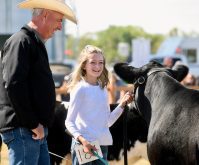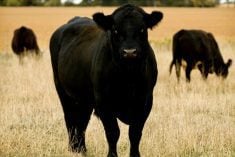Beleaguered ranchers with quarantined herds are getting some relief as the Canadian Food Inspection Agency has approved a beef industry plan to allow calves to be sent to feedlots.
“We’re working with the CFIA on the conditions and requirements,” said Rich Smith, executive director of Alberta Beef Producers. “Obviously, it would be hard to get feedlots to accept quarantined calves unless they know exactly what is going to be in store for them — particularly what would be the impact on the other cattle in the feedlot.
Read Also

Body condition, nutrition and vaccination for brood cows
One of the remarkable events of the past century related to ranching has been the genetic evolution of brood cows….
“We’re trying to get those details completed, and once they are, it would be a case of producers and our organization approaching feedlots to see if they would be willing to take these quarantined calves. This will be quite a relief for some of those ranchers who just don’t have the facilities for the calves.”
The CFIA began the quarantine in southeastern Alberta after a cow infected with bovine tuberculosis was traced back to a herd near Jenner in late September. At press time, the CFIA said “roughly 50” premises were under quarantine — all but a handful in Alberta. Of those, cattle from 18 premises were in what the CFIA called the “herd” of animals known to have commingled with infected cattle form the herd that had the first confirmed cases of TB.
The “herd” numbers about 10,000 cattle and all will be destroyed.
“We have determined the degree of contact poses the same risk for all animals with exposure to the six confirmed cases, so we are taking similar control actions,” chief veterinary officer Dr. Harpreet Kochhar said. “This is to be expected.”
Nearly all the adult animals in that “herd” have been tested, but calves will be destroyed without testing, the CFIA said. Meat from destroyed animals that are later ruled to have been TB-negative will be eligible for food use.
At press time, there were six confirmed TB cases, all from the original infected herd, and while the CFIA increased testing in recent weeks, “it will still take several months” to complete the testing, Smith said in an interview Nov. 25.
“They’re about a third of the way through the cattle that they need to test, and it’s been a month to get to this point,” he said. “We think they can go a little faster, so hopefully, it won’t take them two more months to get through the remaining two-thirds. But it could.”
Some of the tests on live animals have resulted in false positives, so that’s delaying the process, said Smith.
“If they have a positive reaction to the live test, they won’t confirm that the animal has TB until they get the results of the tissue culture, and those take eight to 12 weeks,” he said. “I think it will still be some months before we have herds coming off quarantine.”
‘Huge cloud’
But as testing on the roughly 22,000 head of cattle stretches on, the ranchers with quarantined herds are feeling the strain of feeding cattle that they would normally be selling this time of year.
“They’re holding up as well as you could expect under the kind of pressure and stress they’re facing,” said Smith. “There’s still a lot of uncertainty for the producers that haven’t been tested yet. You know you have these costs of holding these animals, but you don’t know how long.
“You have this huge cloud of uncertainty hanging over you and you don’t know what’s going to happen to your herd.”
On Nov. 22, rancher Brad Osadczuk told Parliament’s standing committee on agriculture that his operation is sinking deeper and deeper into debt under the quarantine. One of his herds is the “index” herd with the six confirmed cases. But in total, he has 1,200 cows and about the same number of calves under quarantine. When asked about his financial situation, he pointed to one 400-head herd that was at a feedlot when the quarantine was imposed.

“For 400 head, it’s costing me $92,000 a month,” said Osadczuk. “Our bank accounts are frozen. We get paid once a year… We’re overdrawn by hundreds and hundreds of thousands of dollars for these sizes of operations, and we’re paying interest on that money daily… We owe the bank hundreds of thousands of dollars, and now we go, ‘Oh hey, we need a couple hundred thousand dollars for feed for some cows that, in the end, are going to die.’”
Ross White, another affected farmer, had pre-sold calves in early October that were scheduled to be delivered the last week in October and the first week in November.
“The quarantine prevented us from marketing our calves resulting in loss of profit — we were forced to renege on our contracts,” said White, who testified via video.
“This also put the buyer in a tough spot and may impact future sales to him. There are many costs that we are forced to incur because of the constraints placed on us by CFIA and the federal government.
“Our calves are still on the cow, as we have not been given any direction to when we may be tested and/or when some or all of our cattle will be released from quarantine. We are getting very mixed messages, and the costs continue to rise.”
Federal aid pledged
Producers receive fair market value for any animals that test positive for the disease and are destroyed, but there is currently no compensation for the costs to feed and maintain the animals while testing is underway.
But on Nov. 29, federal Agriculture Minister Lawrence MacAulay told the House of Commons agriculture committee that aid would be coming for quarantined ranchers, possibly within days. He said a dollar figure for the aid package was still being worked out, and his office said the Alberta government and industry would determine the details of how the aid is to be paid out.
In an earlier statement, MacAulay said, “We are committed to compensate these ranchers for the costs they are facing, including interest on their advance payment loans.”
That’s good news for the affected ranchers, said Smith.
“We’ve been encouraging them to provide compensation through the disaster relief framework — AgriRecovery — and I’m thinking that will be the instrument through which they do provide compensation,” Smith said.
Even so, it will still take weeks to process any AgriRecovery funding, and in the meantime, the quarantined ranches will hopefully be able to send some of their calves to the feedlot, said Smith.
“We don’t have control over whether feedlots will do this or not, but with compensation being provided to producers, we’re hoping that that will alleviate the financial burden for producers.”
According to Alberta’s Agriculture Financial Services Corp., the province has already begun the “longer-term analysis of whether future AgriRecovery assistance may be available to producers” affected by the bovine TB outbreak.
With files from staff and Ottawa correspondent Alex Binkley. This article was originally published on the Alberta Farmer Express.
















